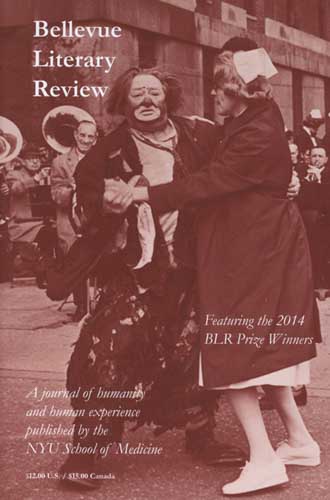Bellevue Literary Review – Spring 2014
Published by the Department of Medicine at NYU Langone Medical Center, Bellevue Literary Review explores literature that addresses aspects of the human condition that relate to health, healing, and disease. In this volume, selections of poetry, fiction, and nonfiction recover images from hospital rooms and doctors’ offices, caregivers’ homes and nurses’ stations. They find language deeply rooted in the human body, with all its strength and resilience, limitation and vulnerability. These selections speak a common language with which most of us can identify and relate. Published by the Department of Medicine at NYU Langone Medical Center, Bellevue Literary Review explores literature that addresses aspects of the human condition that relate to health, healing, and disease. In this volume, selections of poetry, fiction, and nonfiction recover images from hospital rooms and doctors’ offices, caregivers’ homes and nurses’ stations. They find language deeply rooted in the human body, with all its strength and resilience, limitation and vulnerability. These selections speak a common language with which most of us can identify and relate.
As you may guess, this journal is not for the squeamish. If you are a reader who feels faint at the sight of blood, if you need to whisper the word “cancer,” this may not be the journal for you. Many pieces in this volume traverse emotionally difficult territory. They ask us to look human suffering straight in the eye. And while they don’t always offer happy endings, they challenge us, emotionally and intellectually, to probe mysteries and address our fears.
The stories and nonfiction selections are primarily straightforward narratives that employ clear, precise language. This volume brings together a number of emerging and established writers. I’m impressed with the integrity in the voices present in this volume. While these voices are uniquely different, they all avoid overwrought medical jargon and clichéd literary phrasing. They use accessible diction with clean precision.
One such voice is that of Lilliam Rivera. In her story, “Death Defiant Bomba or What To Wear When Your Boo Gets Cancer,” Rivera employs striking prose rhythms to create a second-person, stream-of-consciousness narrative that places her readers in the six-inch black pumps of the street-wise, confident young woman who believes she can keep trouble at bay by staying strong and dressing the part. The morning of her husband’s medical appointment, she chooses the red dress from her closet and imagines how the day will unfold:
The red will wake the receptionist up like a motherfucker and cause her to send you hate for daring to outshine her that morning. The receptionist will think you’re tacky, loud, too much. In the bloodshot color, the doctor will notice that you wore the equivalent of a flag and think you’re stately and in charge. You’ll wear red, definitely red.
But what happens if the tough attitude and the loud dress aren’t enough to deflect her husband’s diagnosis? In this story, Rivera questions how we change when we learn we are not impervious. This story examines how serious illness affects our sense confidence, control, defiance, and power.
In her memoir piece “Measuring Time,” Leslie Van Gelder meditates on time and loss as she recounts the events that predicate her husband’s illness and subsequent death. She recalls how time changes “in the otherworld of the hospital,” where she marks each stage of her husband’s illness as an “era.”
Hospitals create their own form of Time, one that is almost geologic in feel, creating eras and epochs like those charts every student of evolution memorizes . . . The surgeries and the scans, chemo days and nights, they all exist in an otherworldly space as if once one enters the hospital, Time’s very nature changes.
In this quiet, first person account of suffering and loss, Gelder considers how passage of time changes in times of crisis; she meditates on the distinction between time passage on the clock and time passage in the mind.
A number of the selections are written by health care professionals. In “Double Exposure,” Elisha Waldman, a pediatric oncologist from Jerusalem, performs his hospital rounds as he becomes increasing aware of the war that rages outside the hospital walls. He begins his memoir with the observation: “In the midst of the latest outbreak of hostilities between Israel and Gaza, the Department of Pediatric Oncology at our hospital in Jerusalem feels haunted.”
As he visits a succession of young cancer patients, he acknowledges the battles these children endure within their bodies. Likewise, as he hears news about the war—a cancer itself—spreading outside the hospital, he notices how the personal battles inside ominously reflect the larger societal battle outside. As a doctor, he faces his own limitations in providing peace and comfort in such an afflicted world.
Like the prose, most poems in this volume are personal narratives, constructed from language that is accessible and straightforward. These poems evolve from strong imagery and clear diction rather than experimental word play and avant-garde techniques. The poems are playful and precisely crafted. In “Spring Comes, and Then,” Kaitlin LaMoine Martin’s sharp lyricism and concise, inventive language create a confession to a friend who has been battling cancer:
I wrote your eulogy
today, I’m sorry, it’s a nasty
habit, this gathering
of certainty like soap
to sponge. Too much
and the glass slips,
but it’s beautiful as it breaks,
see? Shards sharp as snapdragons,
sharp as stem cells, sharp
as the lime babysitting my gin
as I sit here, keeping you
in the present tense.
In present tense. Perhaps each selection in this volume aims to capture a sense of hope and strength in the face of physical and emotional challenge and bring it into a reader’s present moment. With its emphasis on universal themes and accessible language, Bellevue Literary Review should appeal to a wide variety of readers.
[blr.med.nyu.edu]





